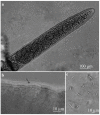Sarcocystis Species Richness in Sheep and Goats from Lithuania
- PMID: 37624307
- PMCID: PMC10458481
- DOI: 10.3390/vetsci10080520
Sarcocystis Species Richness in Sheep and Goats from Lithuania
Abstract
Contradictory data is available on the intermediate host specificity of Sarcocystis spp. in farm animals. Therefore, the current work aimed at molecularly testing samples of sheep and goats reared in Lithuania to identify Sarcocystis species described in other intermediate hosts but suspected to be non-canonical parasites to these small ruminants. For this purpose, muscle samples from 47 domestic sheep and nine goats were examined. Sarcocystis species were identified using direct and nested PCR targeting cox1 and sequencing of positive amplified products. Along with the detection of the canonical Sarcocystis spp. in their respective intermediate hosts, the DNA of S. capracanis and S. morae was detected in sheep, although these species were previously thought to be specific to goats and deer, respectively. In addition, DNA from S. arieticanis and S. tenella was found in goats, even though these two species were believed to be sheep-specific. Notably, under light microscopy, only sarcocysts of S. capracanis specific to goats were observed. Thus, future research on the life cycle and host-specificity of Sarcocystis spp. examined is warranted.
Keywords: Sarcocystis; cox1; intermediate host-specificity; microscopy; phylogeny; small ruminants.
Conflict of interest statement
The authors declare no conflict of interest.
Figures


Similar articles
-
Ultrastructural and Molecular Identification of the sarcocysts of Sarcocystis tenella and Sarcocystis arieticanis Infecting Domestic Sheep (Ovis aries) from Egypt.Acta Parasitol. 2019 Sep;64(3):501-513. doi: 10.2478/s11686-019-00070-8. Epub 2019 Jun 11. Acta Parasitol. 2019. PMID: 31187390
-
Molecular Identification of Sarcocystis Species in Sheep from Lithuania.Animals (Basel). 2022 Aug 11;12(16):2048. doi: 10.3390/ani12162048. Animals (Basel). 2022. PMID: 36009638 Free PMC article.
-
Morphological and molecular characteristics of six Sarcocystis spp. from red deer (Cervus elaphus) in Spain, including Sarcocystis cervicanis and three new species.Parasitol Res. 2017 Oct;116(10):2795-2811. doi: 10.1007/s00436-017-5590-z. Epub 2017 Aug 30. Parasitol Res. 2017. PMID: 28856431
-
A Systematic Meta-Analysis of Global Sarcocystis Infection in Sheep and Goats.Pathogens. 2023 Jul 2;12(7):902. doi: 10.3390/pathogens12070902. Pathogens. 2023. PMID: 37513749 Free PMC article. Review.
-
Current research on Sarcocystis species of domestic animals.Int J Parasitol. 1995 Nov;25(11):1311-30. doi: 10.1016/0020-7519(95)00068-d. Int J Parasitol. 1995. PMID: 8635883 Review.
Cited by
-
The Distribution of Sarcocsytis Species Described by Ungulates-Canids Life Cycle in Intestines of Small Predators of the Family Mustelidae.Acta Parasitol. 2024 Mar;69(1):747-758. doi: 10.1007/s11686-024-00814-1. Epub 2024 Feb 27. Acta Parasitol. 2024. PMID: 38413556
-
Morphological and molecular characterisation of Sarcocystis capracanis, Sarcocystis cornagliai and Sarcocystis rossii n. sp. infecting the Alpine ibex (Capra ibex).Parasit Vectors. 2025 Mar 10;18(1):96. doi: 10.1186/s13071-025-06737-8. Parasit Vectors. 2025. PMID: 40065382 Free PMC article.
-
Detection of Sarcocystis parasites in environmental samples from Lithuanian farms.Food Waterborne Parasitol. 2025 May 8;39:e00267. doi: 10.1016/j.fawpar.2025.e00267. eCollection 2025 Jun. Food Waterborne Parasitol. 2025. PMID: 40474918 Free PMC article.
-
First Observations of Buzzards (Buteo) as Definitive Hosts of Sarcocystis Parasites Forming Cysts in the Brain Tissues of Rodents in Lithuania.Biology (Basel). 2024 Apr 16;13(4):264. doi: 10.3390/biology13040264. Biology (Basel). 2024. PMID: 38666876 Free PMC article.
-
High richness of ungulate Sarcocystis species in intestines of the grey wolf (Canis lupus) from Lithuania.Vet Res Commun. 2025 Jun 23;49(4):235. doi: 10.1007/s11259-025-10804-x. Vet Res Commun. 2025. PMID: 40549019 No abstract available.
References
-
- Dubey J.P., Calero-Bernal R., Rosenthal B.M., Speer C.A., Fayer R. Sarcocystosis of Animals and Humans. 2nd ed. CRC Press; Boca Raton, FL, USA: 2016.
-
- Martínez-Navalón B., Anastasio-Giner B., Cano-Fructuoso M., Sanchez-Martínez P., Llopis-Morant A., Perez-Castarlenas B., Goyena E., de Larrea E.B. Sarcocystis Infection: A Major Cause of Carcass Condemnation in Adult Sheep in Spain. Span. J. Agric. Res. 2012;10:388. doi: 10.5424/sjar/2012102-523-11. - DOI
-
- Bittencourt M.V., Meneses I.D.S., Ribeiro-Andrade M., de Jesus R.F., de Araújo F.R., Gondim L.F.P. Sarcocystis spp. in sheep and goats: Frequency of infection and species identification by morphological, ultrastructural, and molecular tests in Bahia, Brazil. Parasitol. Res. 2016;115:1683–1689. doi: 10.1007/s00436-016-4909-5. - DOI - PubMed
Grants and funding
LinkOut - more resources
Full Text Sources
Miscellaneous

